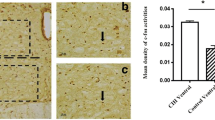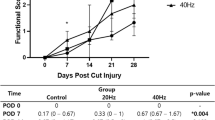Abstract
Ischemic lesions are presumed to be part of many facial nerve pathologies, such as Bell's palsy. The response of facial nerve to hypoxia has not been evaluated previously in an in vitro model. In the present study, the effects of transient anaerobic stress on functional parameters and their recovery were assessed. Extratemporal rat facial nerves were desheathed and incubated in an experimental chamber using solutions containing either low (5 mM) or high (25 MM)d-glucose. In some of the experiments, 40 μM phenytoin or lidocaine was added to observe the effects of membrane stabilizing drugs. Peak height of compound nerve action potential (CNAP), extracellular direct current (DC) potential and latency were measured simultaneously during and after a 40-min period of hypoxia, induced by bubbling the solutions with N2 or application of 3 mM cyanide. This resulted in a rapid decrease of CNAP and a depolarization of the DC potential with a fast and complete post hypoxic recovery. Elevated glucose concentrations led to a slower decline in CNAP and a smaller rise of membrane potential depolarization. This was accompanied by a slower change of latency. However, post-anaerobic recovery was always diminished in the high glucose solutions. In experiments with phenytoin or lidocaine longer impulse conduction during hypoxia was observed. These findings indicate that the availability of energy-rich components underlies the complex array of physiological derangements seen in ischemia. Membrane-stabilizing drugs show an effect on signal conduction during hypoxia and need further exploration.
Similar content being viewed by others
References
Abraham-Impijn L, Oosting J, Hart AA (1987) Bell's palsy: factors affecting the prognosis in 200 patients with reference to hypertension and diabetes mellitus. Clin Otolaryngol 12: 349–355
Adour KK, Wingerd J, Doty HE (1975) Prevalence of concurrent diabetes mellitus and idiopathic facial paralysis (Bell's palsy). Diabetes 24: 449–451
Devriese PP (1974) Compression and ischemia of the facial nerve. Acta Otolaryngol (Stockh) 77:108–118
Fern R, Ransom BR, Stys PK, Waxman SG (1993) Pharmacological protection of CNS white matter during anoxia: actions of phenytoin, carbamazepin and diazepam. J Pharmacol Exp Ther 266: 1549–1555
Hilger JA (1949) The nature of Bell's palsy. Laryngoscope 59: 228–235
Imaizumi S, Kurosawa K, Kinouchi H, Yoshimoto T (1995) Effect of phenytoin on cortical Na+-K+-ATPase activity in global ischemic rat brain. J Neurotrauma 12: 231–234
Lindström P, Brismar T, Sima AAF (1994) Impaired recovery in diabetic rat nerve following anoxic conduction block. Diabetes Res Clin Pract 25: 177–181
Lipicky RJ, Gilbert DL, Stillman IM (1972) Diphenylhydantoin inhibition of sodium conductance in squid giant axon. Proc Natl Acad Sci USA 69: 1758–1770
Lorente de Nó R (1947) A study of nerve physiology. The Rockefeller Institute for Medical Research, New York
Marsh SJ, Stansfeld CE, Brown DA, Davey R, McCarthy D (1987) The mechanism of action of capsaicin on sensory C-type neurons and their axons in vitro. Neuroscience 23: 275–289
Maruhashi J, Wright EB (1967) Effect of oxygen lack on the single isolated mammalian (rat) nerve fiber. J Neurophysiol 30: 434–436
Mori H, Horiuchi M, Nakai Y (1977) Disorders of glucose metabolism in Bell's palsy. In: Fisch U (ed) Facial nerve surgery. Kugler, Amstelveen, pp 364–370
Murakami A, Furui T (1994) Effects of the conventional anticonvulsants, phenytoin, carbamazepine, and valproic acid, on sodium-potassium-adenosine triphosphatase in acute ischemic brain. Neurosurgery 34: 1047–1051
Saito O, Aoyagi M, Tojima H, Koike Y (1994) Diagnosis and treatment for Bell's palsy associated with diabetes mellitus. Acta Otolaryngol [Suppl] (Stockh) 511: 153–155
Schneider U, Jund R, Nees S, Grafe P (1992) Differences in sensitivity to hyperglycemic hypoxia of isolated rat sensory and motor nerve fibers. Ann Neurol 31: 605–610
Schneider U, Niedermeier W, Grafe P (1993) The paradox between resistance to hypoxia and liability to hypoxic damage in hyperglycemic peripheral nerves — evidence for glycolysis involvement. Diabetes 42: 981–987
Schneider U, Quasthoff S, Mitrovic N, Grate P (1993) Hyperglycemic hypoxia alters after-potential and fast K+ conductance of rat axons by cytoplasmic acidification. J Physiol (Lond) 465:679–697
Shirabe S, Kinoshita I, Matsuo H (1988) Resistance to ischemic conduction block of the peripheral nerve in hyperglycemic rats: an electrophysiology study. Muscle Nerve 11: 582–587
Siesjö, BK (1988) Acidosis and ischemic brain damage. Neurochem Pathol 9: 31–88
Sohn RS, Ferrendelli JA (1973) Inhibition of Ca2+ transport into rat brain synaptosomes by diphenylhydantoin (DPH). J Pharmacol Exp Ther 185: 272–275
Steiness IB (1959) Vibratory perception in diabetics during arrested blood flow to the limb. Acta Med Scand 163: 195–205
Stennert E (1981) Pathomechanism in cell metabolism: a key to treatment of Bell's palsy. Ann Otol Rhinol Laryngol 90: 577–580
Strupp M, Bostock H, Weigl P, Piwernetz K, Renner R, Grafe P (1990) Is resistance to ischemia of motor axons in diabetic subjects due to membrane depolarization? J Neurol Sci 99: 271–280
Strupp M, Jund R, Schneider U, Grafe P (1991) Glucose availability and sensitivity to anoxia of isolated rat peroneal nerve. Am J Physiol 261: E389-E394
Wright EB (1947) The effects of asphyxiation and narcosis on peripheral nerve polarization and conduction. Am J Physiol 148:174
Author information
Authors and Affiliations
Rights and permissions
About this article
Cite this article
Jund, R., Kastenbauer, E. Susceptibility of isolated rat facial nerve to anaerobic stress. Eur Arch Otorhinolaryngol 254 (Suppl 1), S64–S67 (1997). https://doi.org/10.1007/BF02439727
Issue Date:
DOI: https://doi.org/10.1007/BF02439727




